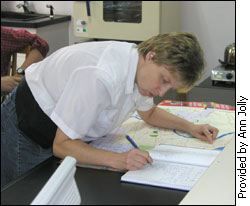| Let's
talk about sex
By Katie Cumby
OTTAWA —
Ann Jolly likes to talk about sex,
but not in the way you might think.
 |
| Jolly outlining sexual networks
in her laboratory. |
Jolly is a senior research epidemiologist
for the Centre for Infectious Disease Prevention and
Control at the Public Health Agency of Canada.
Jolly studies the transmission of
sexually transmitted infections and other infectious
diseases.
Research focus
The area she’s most interested in
is sexual networks of infected people. In 2004, Health
Canada awarded Jolly the Most Promising Scientist Award
to recognize her work in this field.
Studying sexual networks helps show who
is having sex with whom, says Jolly. This data can then
be used to examine disease and infection transmission.
"In these networks, people can be
attached in a kind of web-like thing, like a spider
web," says Jolly, who completed her PhD in community
health sciences at the University of Manitoba in 1998.
"But we also have to remember
that sometimes someone in a network isn’t linked
to everybody else," she says.
All the people who have STIs are in a
network, but only some are linked to each other in what
is called a component.
| 'In these networks,
people can be attached in a kind of web-like thing,
like a spider web.' |
Sexual networks can show us how
people are indirectly sexually connected to each other.
For example, if Jane has sex with
John and John has sex with Mary, Jane and Mary are indirectly
linked in the sexual network.
Talking about sex . . . in Manitoba
Jolly has lived in Ottawa for seven years.
She says the springboard for her career was a 5-year
research project, funded by the Manitoba Health Research
Council, that looked at chlamydia sexual networks in
Manitoba. The results were peer reviewed and published
in The Journal of Infectious Diseases.
Jolly worked with John Wylie, a scientist
with Manitoba Health. They combined sexual network data
and genotype data of people with chlamydia.
They compared these two data types to
see if the chlamydia strain passed along in certain
sexual networks matched the infected people said they
had sex with.
"When people say they had sex with
each other, we learned that it’s often supported
by the fact that they all have the same strain,"
says Jolly.
The purpose of genotyping data, says Jolly,
is to look for different strains of a disease or infection.
| 'When people say
they had sex with each other, we learned that it’s
often supported by the fact that they all have the
same strain' |
"When we genotype data, we’re
just taking the bug, taking the DNA, looking at the
proteins and we see if it’s identical to another
type," says Jolly.
How they did it
Using a test called Chlamydiazyme,
they analyzed samples from people who were infected
in 1997 and 1998.
Public health nurses then asked them for
personal information, like their gender, race, birth
date and address. They also asked them for the names
of their sexual contacts.
Using a network analysis program called
PAJEK, Jolly and Wylie constructed sexual networks that
made links between infected people. They genotyped chlamydia
specimens from 359 people.
- Half of of these people said
they lived in Winnipeg
- Sixty-seven per cent reported
they were 15-24 years old.
- Twenty-nine per cent said
they were 25-39 years old.
- More than three quarters of
them were females.
|
Of these 359 people, they looked
at specimens of 297 to see whether or not there was
a relationship between the sexual network and the genotype
data.
Inspiring results
"We found that about 60 per cent
of networks had one strain, which supports the patients’
responses about who they said they had sex with,"
says Jolly. "You can see that the genotype data
correlates quite well with the person with whom they
said they’ve had sex."
According to Jolly, about 30 per cent
of the networks they studied contained more than one
chlamydia strain, suggesting, among other findings,
that some of the sexual partner links were missing.
These results inspired Jolly to continue
looking into sexual networks and genotyping. Jolly and
Wylie have looked at these two concepts in relation
to geographical, spatial and temporal clustering of
strains of chlamydia and other diseases and infections.
"These studies made us want
to start looking at other organisms. So for example,
if this works with this STI, will it work with others?"
Talking about sex — now and in
the future
Jolly and Wylie are currently studying
sexual networks and different strain types of gonorrhea
in Shanghai, China. Jolly says the ultimate goal of
this and all of her studies is to help minimize how
many people contract sexually transmitted infections
and other infectious diseases.
"We know there’s people
out there who are having sex together and they form
a sexual network which somehow we need to break into,"
she says. "We need to get into that and look at
what we can do to help these folks."
|